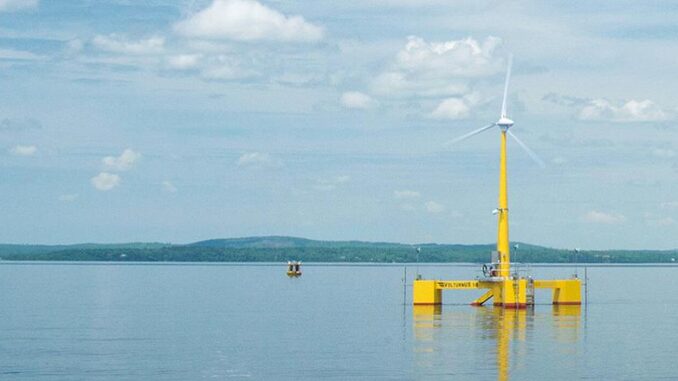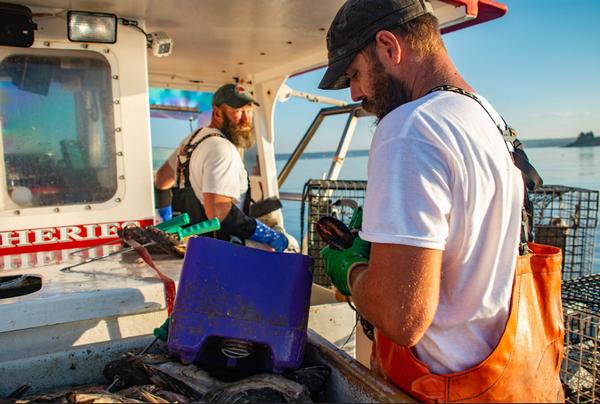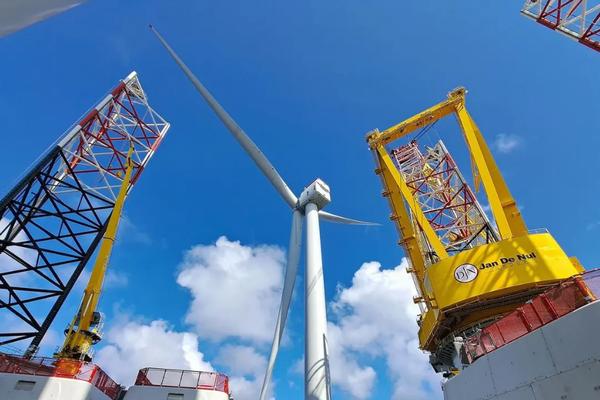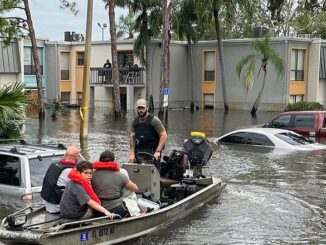
WASHINGTON, DC, August 20, 2024 (ENS) – The first U.S. floating offshore wind energy research lease was granted to the State of Maine by the Bureau of Ocean Energy Management, BOEM, on Monday. The lease area covers nearly 15,000 acres located 28 nautical miles offshore Maine on the U.S. Outer Continental Shelf.
The lease could allow for the deployment of up to 12 floating offshore wind turbines capable of generating up to 144 megawatts of renewable energy. Research will evaluate the compatibility of the array of wind turbines with existing ocean uses and assess potential effects on the environment, supply chains, and job creation.
“Floating wind opens up opportunities to produce renewable energy in deeper water farther offshore,” said BOEM Director Elizabeth Klein. “Signing the Gulf of Maine research lease demonstrates the commitment by both BOEM and the State of Maine to promote a clean energy future for the nation. It is another example of a successful all-of-government effort to reach the administration’s offshore wind energy goals and to combat the impacts of climate change.”
As a research lease, the State of Maine or its designated operator will propose and conduct research regarding environmental and engineering aspects of the proposed project. This information will be made public and used to inform future planning, permitting, and construction of commercial-scale floating offshore wind projects in the region.

The research array will allow the state, the fishing community which has protested the wind turbine array, wildlife experts, the offshore wind industry, and others to conduct in-depth studies and evaluate floating offshore wind as a renewable energy source in the region.
Earlier this year, the Bureau of Ocean Energy Management designated the final Wind Energy Area for the Gulf of Maine. That area excludes the entirety of Lobster Management Area 1, as requested by Governor Mills and Maine’s Congressional Delegation. BOEM plans to host a commercial offshore wind lease auction by the end of 2024.
BOEM manages development of U.S. Outer Continental Shelf energy, mineral, and geological resources. Information gathered from the research lease will inform responsible commercial floating offshore wind development in the future and allow BOEM and Maine to capitalize on innovative technology, while protecting local and national interests and industries.
Clean Energy Good for Maine, Good for the Nation
“Clean energy from offshore wind offers an historic opportunity for Maine to create good-paying jobs, reduce our reliance on fossil fuels, and fight climate change by cutting greenhouse gas emissions,” said Maine Governor Janet Mills.
“This lease between the State and BOEM to support the nation’s first research array devoted to floating offshore wind technology is the result of extensive engagement with stakeholders and communities across our state to establish Maine as a leader in responsible offshore wind, in balance with our state’s marine economy and environment,” Governor Mills said.
BOEM received an application from the State of Maine for a renewable energy research lease in October 2021. On March 20, 2023, BOEM issued a Determination of No Competitive Interest for the area identified in Maine’s application.
BOEM engaged with the State of Maine Governor’s Energy Office throughout the application review and lease development process to develop a lease that yields high-quality research on offshore wind in the Gulf of Maine.

On May 24, 2024, BOEM offered a research lease to the State of Maine after completing a Final Environmental Assessment and associated finding of no significant impacts.
“Offshore wind technology presents a historic and promising opportunity to further grow our economy, support hardworking Maine people and pave the way for a cleaner, greener tomorrow,” said U.S. Senator Angus King. “This floating research lease represents a continued investment in innovative offshore wind technology and research, and will help Maine embrace a secure, sustainable energy future – while striking an important balance with the needs of our fisheries and fishing communities.”
As proposed, the research array will use floating offshore wind platform technology designed by the University of Maine and deployed by its development partner, Diamond Offshore Wind. UMaine’s floating platform, known as VolturnUS, was recently awarded a $12.5 million grant from the U.S. Department of Energy for its innovative design.
Construction activity on the research array is not likely to occur for several years. The lessee is first required to submit a Research Activities Plan to BOEM, which will undergo environmental analysis under the National Environmental Policy Act.
In addition, Maine is investing in a new purpose-built port in Searsport for offshore wind fabrication, staging, assembly, maintenance, and deployment. With deepwater access to the port development site, Maine has the potential to establish a premier location for the industry and help meet growing demand in the for offshore wind port infrastructure in the United States.
Biden’s Larger Offshore Wind Energy Results
Since the start of the Biden-Harris administration in January 2021, the Department of the Interior has approved the nation’s first nine commercial scale offshore wind projects with a combined capacity of more than 13 gigawatts of clean energy – enough to power nearly five million homes.
During that time period, the department has held five offshore wind lease auctions – including a record-breaking sale offshore New York and the first sales offshore the Pacific Coast and in the Gulf of Mexico.
Since the start of the Biden-Harris administration, the Department of the Interior has approved the nation’s first nine commercial scale offshore wind projects, held five offshore wind lease auctions, a record-breaking sale offshore New York and the first-ever sales offshore the Pacific and Gulf Coasts, and advanced the process to establish additional Wind Energy Areas in Oregon and the Gulf of Maine.
Following completion of the fifth offshore wind lease sale held during the Biden-Harris administration, on August 14 the Department of the Interior announced the results of BOEM’s wind energy auction for two lease areas offshore the states of Delaware, Maryland and Virginia. Six companies participated in the auction. The sale – the first in the region in a decade – resulted in two provisional winners and $92.65 million in winning bids.

Equinor Wind US LLC, the U.S. division of a Norwegian company, provisionally won Lease OCS-A 0557 at $75,001,001, which consists of 101,443 acres and is 26 nautical miles from Delaware Bay.
Virginia Electric and Power Co provisionally won Lease OCS-A 0558 at $17,650,500, which consists of 176,505 acres and is 35 nautical miles from the entrance of Chesapeake Bay.
“Today’s lease sale represents a major milestone in meeting the demand for clean renewable energy along the East Coast,” said BOEM Director Klein. “BOEM remains committed to responsible offshore wind energy development in the Central Atlantic region in a manner that avoids, reduces or mitigates potential impacts to other ocean users and the marine environment while growing local economies.”
The interest in this sale and its success helps the Biden-Harris Administration approach its goal of deploying 30 gigawatts of offshore wind energy capacity by 2030 and 15 gigawatts of floating offshore wind energy by 2035.
“At the start of the administration, our nation had approved zero offshore wind energy projects. Today, we have nine – enough to power nearly five million homes. This is what developing a clean energy transition looks like,” Secretary of the Interior Deb Haaland said.
“Together, we are demonstrating that, in partnership with states, Tribes, ocean users and industry, we can build an entirely new and sustainable industry that will meet the growing demands of our nation far into the future, while creating good-paying jobs and helping mitigate the threat of the climate crisis,” Secretary Haaland said.
Earlier this year, Secretary Haaland announced a schedule of additional lease sales through 2028. The department has taken steps to grow a sustainable offshore wind industry by encouraging the use of project labor agreements, strengthening workforce training, bolstering a domestic supply chain, and through enhanced engagement with Tribes, fisheries, communities and ocean users.
Featured image: University of Maine’s floating wind turbine and platform, known as VolturnUS. 2019 (Photo courtesy University of Maine)
© 2024, Environment News Service. All rights reserved. Content may be quoted only with proper attribution and a direct link to the original article. Full reproduction is prohibited.



